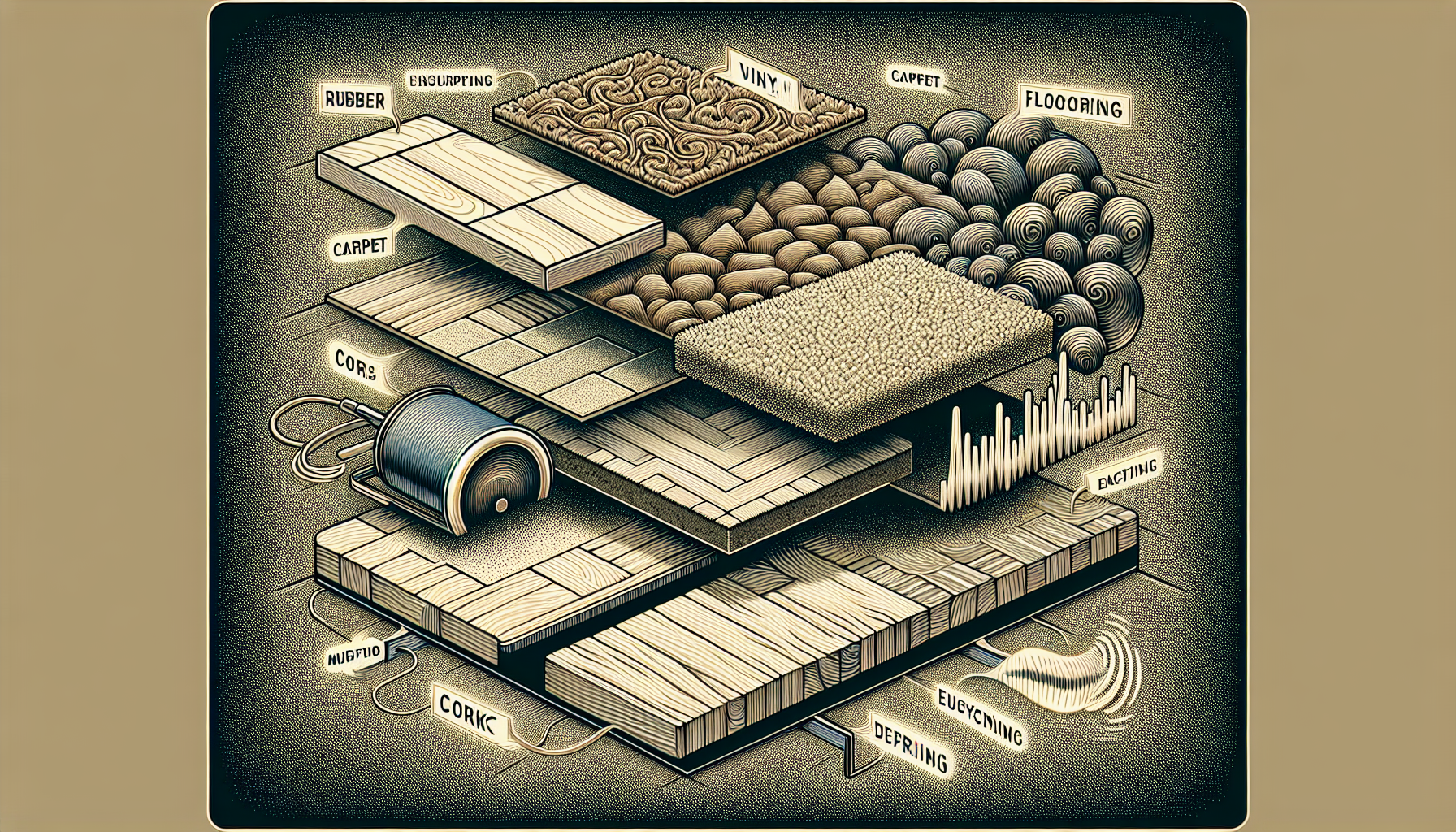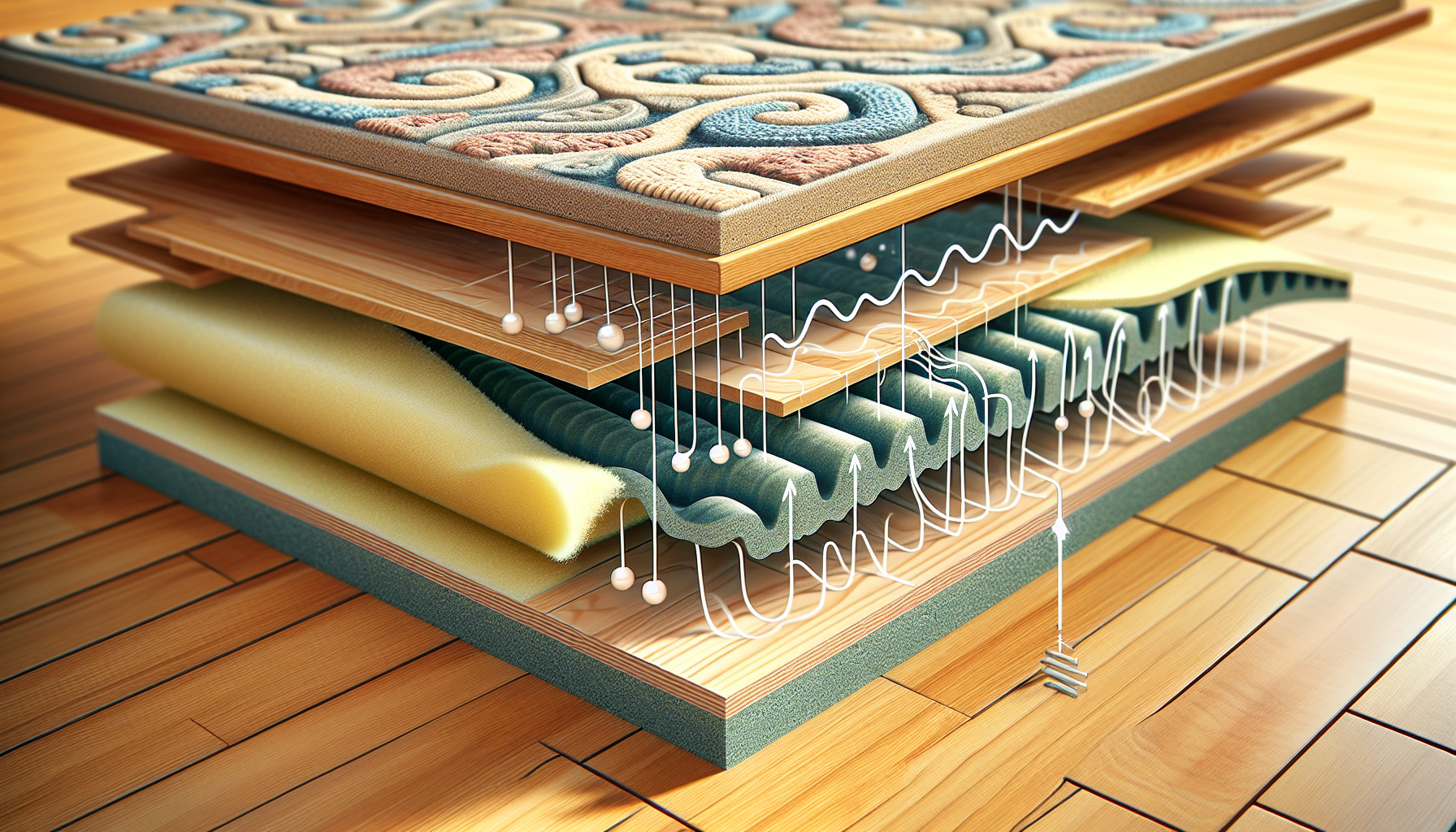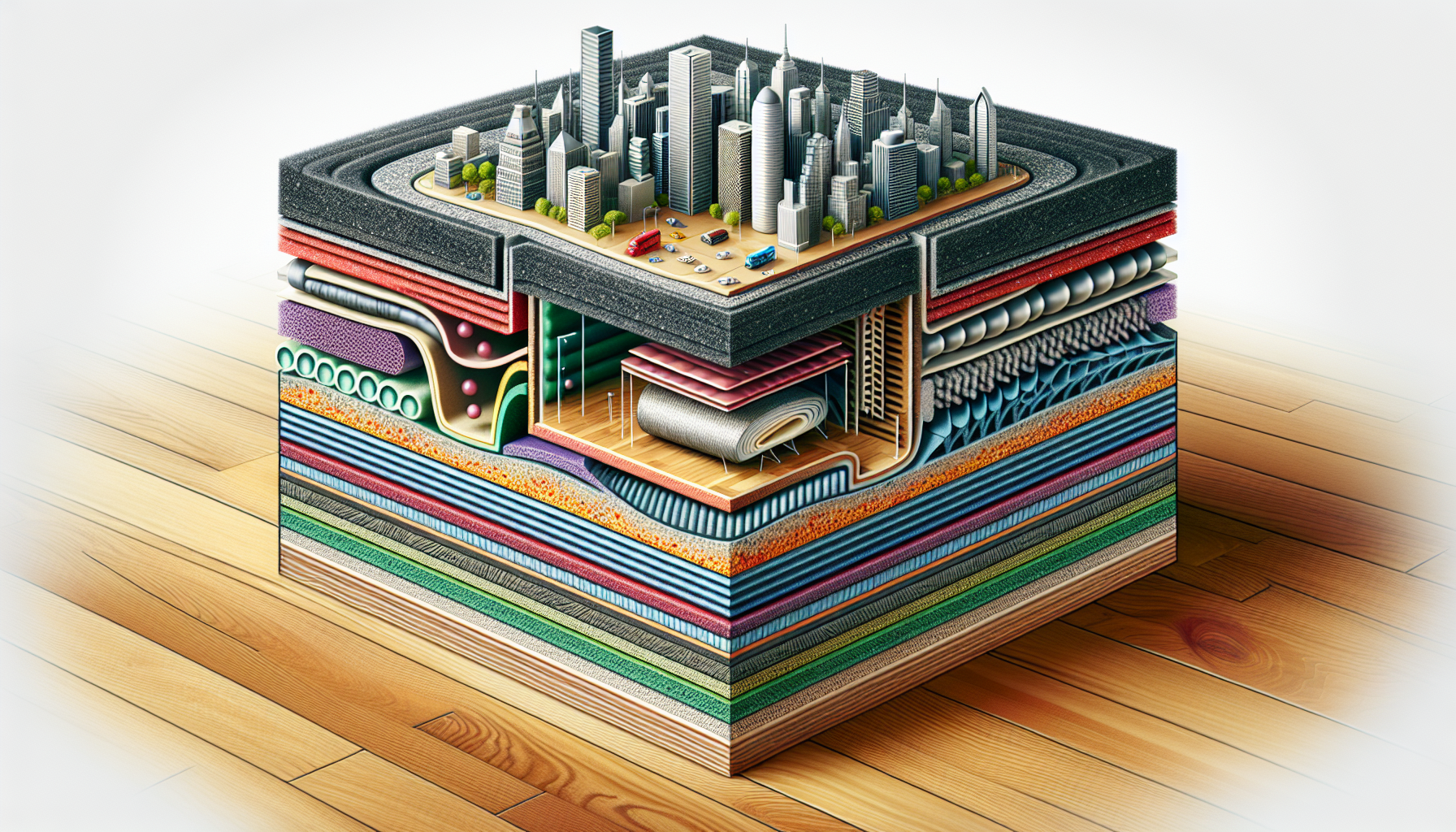

For anyone seeking to enhance their space’s sound dynamics, flooring that improves acoustics goes beyond mere aesthetics. Whether reducing unwanted noise or fostering clear audio resonance, the right flooring choice is pivotal. This article will guide you through the top flooring options designed to optimize acoustic performance, without overwhelming you with complex acoustical terms.
Acoustic flooring is designed to reduce both impact and airborne noise, enhancing acoustic comfort in various spaces. Its effectiveness is measured by Sound Transmission Class (STC) and Impact Insulation Class (IIC) ratings, which consider factors such as thickness and density of materials like mineral wool, acoustic panels, and foam.
Several flooring materials are recognized for their superior acoustic properties, including rubber flooring, carpet and carpet tiles, luxury vinyl tile (LVT), cork flooring, and wood plastic composite (WPC) flooring. These materials offer durability, design versatility, and effective sound absorption, often enhanced by specialized backings or underlayment.
Improving existing floor acoustics can be achieved through the use of acoustic underlays, floating floors, and the addition of mass with materials like soundboard or cement board. These solutions can significantly reduce noise and vibration transmission without the need for complete floor replacement.

Acoustic flooring is a unique surface. It is a specially designed layer of material that serves as a barrier, preventing sound transmission between floors and targeting the reduction of both impact and airborne noise. This makes acoustic flooring an essential component for enhancing acoustic comfort in both residential and commercial spaces. Imagine being in a bustling office or a lively home, yet being able to maintain a degree of tranquility. This is the magic of acoustic flooring.
You might wonder how acoustic flooring achieves sound absorption and blocks transmission. The answer lies in the science of sound absorption and strategic use of materials with soundproofing properties. From the soft padding beneath your carpet to the dense layer of mineral wool in your office floor, these materials play a crucial role in absorbing sound energy and preventing its travel through the floor.
Remember, however, that not all acoustic flooring is the same. Factors to consider when selecting soundproof flooring include its intended application, Sound Transmission Class (STC) and Impact Insulation Class (IIC) ratings, and the thickness and density of the material. After all, you wouldn’t want to invest in a flooring solution that falls short of your noise reduction needs, would you?
Acoustic flooring isn’t just about reducing noise. It’s about creating superior sound quality and comfort in a space. The overarching objective of sound treatment incorporates the prevention of sound transfer between areas and the reduction of background noise. Whether you’re designing a new office, renovating your home, or upgrading a commercial space, having acoustic flooring can make a world of difference in creating an environment that’s conducive to work, rest, or play.
Essentially, acoustic flooring focuses on managing sound. It features a material layer that serves as a barrier to block sound transmission between floors. This layer is made up of various materials such as:
mineral wool
rockwool insulation
acoustic panels
foam
All of these materials are known for their soundproofing properties. They absorb sound energy and prevent its travel through the floor, reducing both impact and airborne noise.
This is particularly beneficial in residential spaces, where noise-induced sleep disturbance can be minimized by reducing intrusive noises such as conversations and TV. To evaluate their effectiveness, acoustic floors undergo tests that measure airborne sound insulation, considering noises typical in residential settings and assessing the collective impact of all structural materials in a building.
Absorbing sound is a science, and it’s fascinating. To create a serene environment, you need to stop sound waves from reverberating within a space. This is where sound-absorbing floor insulation comes in. It serves to create a dense layer that prevents sound waves from bouncing around.
To improve the quality of sound within a room, lighter and less dense materials are utilized to reduce echoes. This results in a better acoustic environment for listening and speaking. So, the next time you step into a room and notice the hushed atmosphere, remember that there’s a science behind that tranquility.
In the world of acoustic flooring, the Impact Insulation Class (IIC) rating is a crucial measure of a material’s effectiveness at preventing the transmission of impact sound. The higher the IIC, the better the sound insulation. From footsteps to furniture moving across the floor, the IIC rating indicates how well a flooring material can block impact noise, contributing to better soundproofing and quieter environments.
So, if you’re considering acoustic flooring for your space, don’t forget to check out the IIC ratings!

Choosing the right acoustic flooring material can be quite a task, given the plethora of options available. But don’t worry, we’ve got you covered. Some of the top flooring options renowned for their sound-absorbing qualities include:
Rubber flooring
Carpet and carpet tiles
Luxury vinyl tile (LVT) flooring
Cork flooring
Wood plastic composite (WPC) flooring
These materials, designed specifically for acoustic performance, range from mineral wool, rockwool insulation, foam, to acoustic panels.
Let’s examine some of these materials in more detail.
Rubber flooring is one of the top choices when it comes to sound absorption. Here are some reasons why:
It offers extreme sound absorption capabilities
It’s incredibly durable, making it particularly suitable for fitness flooring and other specific applications
It’s beneficial in healthcare settings as it minimizes footfall sound
It’s easy to maintain
In educational facilities, premium rubber flooring offers several benefits:
It diminishes noise levels by up to four times compared to vinyl composite tile.
It contributes to a better learning environment.
It provides a unique design option that is also acoustically efficient.
So, if you’re looking for a flooring option that combines aesthetics and functionality, rubber flooring might be the way to go.
If you’re looking for a flooring option that’s not just effective for sound absorption but also offers visual comfort and style, consider carpet and carpet tiles. These floor coverings are recognized for their natural sound dampening properties, which play a crucial role in reducing echo and reverberation, thereby minimizing bothersome noise stemming from footfall and airborne sounds.
They are easy to install and replace, making them an attractive option for areas with high foot traffic. Plus, they offer additional benefits, including enhanced underfoot comfort, extended carpet life due to protection from wear and tear, and natural flame retardancy for safety.
Luxury Vinyl Tile (LVT) flooring is not just about aesthetics. It offers a range of benefits, including:
Reducing sound, particularly from heavy foot traffic or objects rolling over the surface
Being versatile and low-maintenance
Being durable and long-lasting
Having a variety of designs to choose from
Having sound-absorbing properties
Certain types of LVT, such as rigid core click and loose lay, are particularly noted for their acoustic properties due to specialized backings that enhance sound reduction.
Acoustic underlayment made of foam or recycled fibers can be used beneath LVT to provide additional cushioning and improve its sound-absorbing qualities.

If you’re not in the position to replace your entire floor, don’t worry. You can still enhance the acoustics of your existing floors by:
Adding a resilient layer for floating floors
Installing acoustic underlays beneath the flooring surface
Implementing acoustic overlays above the subfloor
These approaches can significantly improve the acoustics of existing floors.
It’s akin to rejuvenating your old floor!
With the assistance of acoustic underlays, old floors can attain a new, soundproof existence. These underlays enhance the sound insulation of existing floors without the need for replacing them. They are crafted from a variety of materials including stone wool, foam, or felt, designed to sit beneath the main flooring to inhibit the transmission of sound waves and thus contribute to a more serene indoor atmosphere.
And the best part? You can choose from a range of materials to suit your specific needs and preferences.
Floating floors are another great way to enhance the acoustics of your existing floors. Acting as a noise-reducing layer installed over the original subfloor, floating floors help cut down on the transmission of sounds. The air gap created by the resilient layer under a floating floor is crucial for minimizing vibration transmission between the floor and the subfloor.
Made from a variety of materials, including wood, laminate, vinyl, or carpet, floating floors are a surefire way to dampen vibrations and reduce sound transmission.
Increasing the mass of your floor can markedly lessen sound transmission. This can be achieved by installing materials like soundboard or cement board to increase the mass of a floor. Multiple layers of dense materials, including soundboard, can be layered to enhance the mass and decrease the floor’s vibration from sound.
Using mass-loaded vinyl to increase floor mass can notably diminish the transmission of airborne noise. So, if you’re looking for a solution that doesn’t involve replacing your entire floor, adding mass might be the answer.

Technological advancements have led to an abundance of innovative solutions for soundproofing floors. Some of these solutions include:
Acoustic underlays
Acoustic mats
Mass-loaded vinyl
Compounds like Green Glue
In addition to using these materials, it is also important to design with both aesthetic and acoustic considerations in mind. By incorporating these innovative solutions, you can significantly reduce both noise transmission and structure borne noise, as well as impact vibrations.
Gone are the days when underlays were just a simple layer beneath your floor. With modern advancements, acoustic underlays now harness materials such as rigid fiberglass and specialized foams that are adept at capturing a wide spectrum of sound frequencies, both low and high. Not only do they significantly reduce noise transmission, but they also offer enhanced comfort and thermal insulation, thanks to the utilization of dense, durable materials like rubber.
Sound ratings are a key factor in assessing the efficacy of acoustic insulation flooring. The sound transmission class (STC) rating is a standardized measure used to gauge how much sound a product, like flooring, can block. A higher STC rating reflects greater sound blocking capability, with a rating below 40 seen as inadequate, 45 offering moderate privacy, 50 as satisfactory for dwellings, and 55 or above recommended for significant noise mitigation, especially from music.
So, don’t forget to check out the sound ratings when choosing your acoustic flooring.
Why stop at floors when you can enhance the acoustics of your entire space? By selecting wall treatments that synergize with the acoustic properties of the chosen floor materials, you can significantly enhance the effectiveness of soundproofing.
Combining reflective materials, like wood or metal, with sound-absorbing elements such as acoustic panels or ceiling clouds can create spaces that are both visually appealing and acoustically comfortable.
Let’s look at some real-world examples of acoustic flooring in action. These case studies showcase the successful implementation of acoustic flooring in diverse settings and highlight the practical impact of the solutions discussed above.
In the commercial world, sound-absorbing flooring has proven to be a game-changer. Here are some examples of its effectiveness:
Foxhills Country Club chose the JCW Acoustic Cradle system for their new family building to enhance sound insulation.
Premier Inn at Castle Quay, Banbury, addressed their soundproofing needs using JCW Acoustic Deck 28.
Bentley Motors’ new emissions building in Crewe was fitted with Cellecta Screedboard 20 for noise control.
These success stories illustrate just how effective acoustic flooring can be in commercial applications.
Educational and healthcare facilities present unique challenges when it comes to acoustics. With classrooms and hospital wards requiring a quiet environment, the choice of flooring material is crucial. Greater Peterborough UTC College is a great example of how the JCW 80T Acoustic Batten System can enhance the acoustic environment in an educational setting.
Similarly, in healthcare settings, acoustic flooring is crucial for reducing noise, which contributes to patient satisfaction and may potentially shorten recovery times.

A holistic approach is required when designing with acoustics consideration, from selecting flooring material to the spatial design itself. It’s about creating spaces that are both visually appealing and acoustically comfortable.
Matching acoustic flooring with interior aesthetics is one strategy for designing with acoustics in mind. Engineered hardwood or laminate flooring with built-in sound-absorbing layers can serve a dual function of enhancing room aesthetics while providing necessary soundproofing.
Additionally, soundproofing solutions like underlays that fit seamlessly beneath flooring or decorative rugs can be chosen to complement the room’s style and provide acoustic comfort.
Residential acoustic comfort is another important consideration when designing with acoustics in mind. By using floor treatments that minimize sound transmission, dampen vibrations, and reduce echoes, you can create a more tranquil environment in your home.
The White Wool Felt Carpet Underlay, for instance, is particularly suitable for bedrooms and living rooms, illustrating the practical application of acoustic underlays in residential settings.
So, there you have it - an in-depth guide to acoustic flooring. From understanding the role of acoustic flooring in sound management to exploring the top flooring materials known for their superior acoustic properties, we’ve covered it all. We’ve also looked at innovative solutions for soundproofing floors and delved into real-world case studies of acoustic flooring in action. Remember, designing with acoustics in mind is not just about reducing noise; it’s about creating spaces that are both visually appealing and acoustically comfortable. So, whether you’re renovating your home, designing a new office, or upgrading a commercial space, consider the power of acoustic flooring. It’s time to turn down the noise and turn up the tranquility!
Yes, top-quality vinyl flooring with foam backing is good for acoustics due to its sound absorption properties. Be sure to seek out top-quality options for the best results.
Carpeting is the best flooring for reducing footfall and impact noise. If you have hardwood, ceramic tile, or laminate flooring, consider adding heavy-duty soundproofing flooring on top for noise reduction.
To enhance the acoustics of existing floors, consider adding a resilient layer, installing acoustic underlays, or implementing acoustic overlays. These methods can significantly improve sound quality in a space.
Innovative solutions for soundproofing floors include using advanced materials such as acoustic underlays, mats, mass-loaded vinyl, and compounds like Green Glue, while also considering both aesthetic and acoustic aspects in the design. These solutions can significantly reduce noise transmission through floors.
Sound ratings such as the Sound Transmission Class (STC) rating are crucial in determining the ability of acoustic insulation flooring to block sound, with a higher STC rating indicating better sound blocking capability.